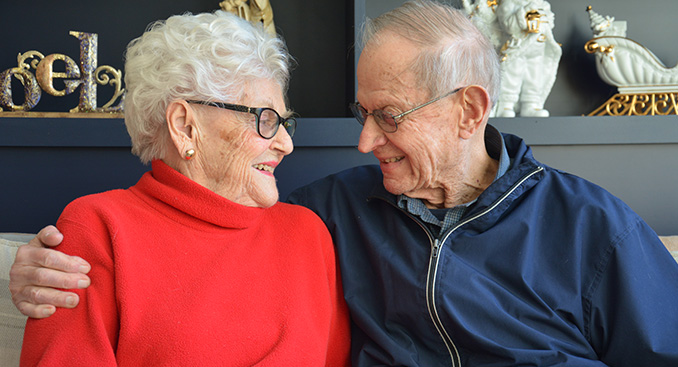A life-saving surgery keeps 94-year old Edward on his feet

When a matter of minutes could mean the difference between saving your limb—or your life—you don’t have time for second guessing. And as Edward Thomas and his wife Pat recently learned, being in the hands of caring medical experts can turn a potential tragedy into a near-miraculous recovery.
At 94 years old, Edward was slowing down, but still very active. When he told his wife after a midday meeting at their retirement community that his leg hurt, she reasoned it was likely a mild cramp that would soon pass, and urged him to sit down. What happened next, however, shocked her.
“He turned to me and said, ‘I can’t feel my leg from the knee on down. I can’t take another step.’ Pat Thomas, 91, explains. “He’d never said anything like that to me before, and I knew we had to get to the Emergency Room right away.” What neither Pat nor Edward realized, however, was that the numbness in Edward’s leg was the result of a life-threatening blood clot, and the clock was already ticking.
The moment they arrived at TriHealth's Bethesda North Hospital, a fast-acting team of medical experts swung into action, quickly identifying the existence of the clot and the need for a vascular surgeon. Aaron Kulwicki, MD, a vascular surgeon with the TriHealth Heart & Vascular Institute, answered the summons. “Mr. Thomas was experiencing pain, numbness, and the inability to move his foot, which constituted a surgical emergency,” Dr. Kulwicki explains. “You have to get blood flow restarted to the threatened limb, and there was no time for imaging except for an angiogram and X-rays on the table. We determined that Edward had a popliteal aneurysm, or a bulge in an artery behind the knee. In 60 percent of these cases, amputation of the limb was the most likely outcome.”
He immediately informed Pat, explaining all the possibilities, but Pat was resolute. “I could not think of any reason why you’d want to take the leg of a 94-year old man,” she says. “Dr. Kulwicki said he absolutely understood, and that he would do what he could. He was a man of his word.”
Prepping for immediate surgery, Dr. Kulwicki performed bypass surgery on the affected leg to restore blood flow, making decisions inter-operatively to save both the limb and Edward’s life. The procedure was a success—and the result of a complete team effort by the TriHealth medical staff.
“The ER doctor on call that day, Dr. Kenneth Jacobs, was outstanding,” explains Dr. Kulwicki. “Without his fast action, we wouldn’t have been in the position we were to save Mr. Thomas’s limb. We also had the best combination of anesthesia and vascular experts as well as the Post-Op nursing team to help Mr. Thomas through every phase of his surgery and recovery.”
Dr. Kulwicki, who received his vascular training at the TriHealth Institute, recently rejoined the Fellowship Training Program after working in Columbus, Ohio for six years. “One of the biggest reasons I decided to return was the commitment to advanced technology and best practices followed by the vascular program here at TriHealth,” Dr. Kulwicki says. “It allows me to bring my best work to the patients, and give them the greatest opportunity for a successful recovery.”
Particularly when it comes to vascular issues, such as Edward’s blood clot, Dr. Kulwicki advises that nothing is more important than rapid action.
“Time is muscle,” he explains. “If you have a situation where you can’t feel your leg, your foot, your hand—chances are good that the blood flow has in some way been cut off from that limb. You must get to the hospital and into surgery as quickly as possible. Minutes matter. Seconds matter. With our team of experts at the TriHealth Heart Institute, we routinely help save patients like Edward Thomas and return them to a robust quality of life.”
For Pat Thomas, that recovery is a blessing every day. “I’ve spoken with Dr. Kulwicki several times now,” she says. “He always explains everything without throwing a bunch of medical terms at me, and he made sure Edward got the best care every step of the way. He’s not just a good doctor, he’s a good person. I always say, treat the people who are taking care of you with kindness and respect, and they’ll do everything they can for you. That certainly has proven true in this case, and Edward and I will be forever grateful.”